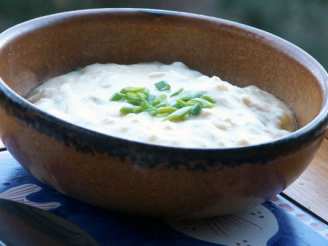Shell's Potato Soup With Carrots

- Ready In:
- 2hrs 30mins
- Ingredients:
- 13
- Yields:
-
6 Lg Soup Bowls with Some left Over
- Serves:
- 6
ingredients
- 5 large potatoes
- 1 bunch carrot (or one large pack of baby carrots)
- 1 large onion
- 1 bunch celery (you will only use half)
- 1 (8 ounce) package bacon
- 1 cup diced tomato (1 can diced tomatoes will work)
- 5 bouillon cubes (or cans of broth to equal about 1 quart)
- 1 tablespoon basil (or oregano as a substitute)
- 1⁄3 cup flour
- 1⁄2 cup milk (or 1/4 cup cream)
- 1⁄2 cup butter (or Margarine)
- 4 bay leaves
- 1 tablespoon salt
directions
- I like to jot down the cookware and supplies you'll need in advance, so that you'll have what you need at the ready.
-
Cookware & other supplies:
- The largest frying pan or skillet that you've got with high sides.
- 1 quart saucepan.
- A really large stewpot with a lid.
- Large mixing bowl (you're going to throw most of your veggies into this bowl once they are prepped).
- smaller mixing bowl (veggies for the roux will go into this bowl, after prep).
- cutting board.
- 1/3 cup measuring cup
- 1/4 cup measuring cup and a 1/2 cup measuring cup.
- a "dipper" of some kind (will be used to dip out the stock with and pour it into your roux gradually, I use an old metal punch bowl dipper).
- potato peeler.
- cheese grater (will be used to grate potato).
- your favorite chopping knife.
- my favorite spatula, I call it the "spatula of wonder".
- your favorite tablespoon (my children swiped mine from my ex-husband somehow and it's the best spoon I've every had. You know, it has a nice heavy feel and it's all curvy and smooth. Don't get me started. I call it the "spoon of wonder". He's never gonna see that spoon again).
- Before you start, fill your 1/4 cup measuring cup with water and pour into your dipper - notice what 1/4 cup of something looks like in your dipper. Do the same with 1/2 your measuring cup. You'll need this information for later.
-
Prep work:
- -Fry the bacon in a crispy style, dry/blot excess grease and put to the side.
- -If using whole large carrots, rather than bagged baby carrots, using the potato peeler, peel the carrots and then trim off the tops and tips. Wash thoroughly. Slice them into pieces 1 inch in diameter. For the bagged baby carrots, slice them in two, if they are more than one inch long (unless they are super skinny) - you want them to be bite sized, allowing for some to cook away. When you're done, put them into the large mixing bowl.
- -Cut four large stalks of celery out of the bunch and also slice the soft, light green celery foliage out of the center of the stalk. Place the soft inner leaves to the side along with any of the very small inner celery stalks that you may have found. Peel the four celery stalks with the potato peeler, careful to peel the edges of the pieces as well (totally necessary to prevent celery "strings" from making it into the soup). Slice off the rough tips and discard. Wash thoroughly. Dice into thin slices, 1/8 inch thick or less if you can accomplish it without hurting yourself (this will make celery almost undetectable in the soup, except for the flavor, which is good for those who say oooh, we don't like celery). Take half and put into the large mixing bowl with the carrots. Put the other half into the smaller mixing bowl for the roux. Wash the baby stalks from the heart of the celery, along with the inner leaves and dice in medium sized pieces (1/4 inch or so). Place all of this into the smaller mixing bowl for the roux.
- Peel the potatoes. Wash thoroughly. Cut one of the potatoes in half and use the cheese grater to grate that half - put the grated potato into the smaller mixing bowl for the roux. With the rest of that potato and the others, slice them into pieces that are between 1 and 2 inches thick, allowing for potato to cook away and still have bite sized pieces. Potato cooks away faster than carrots and so the pieces need to be larger than the cutup carrots. Put the potatoes into the large mixing bowl.
- Peel the onion and wash it thoroughly. Cut it in half, dicing one half into small pieces - put this half into the smaller mixing bowl for the roux. Slice the other half into pieces that are 1/2 to 1 inch in diameter (country style pieces) and put into the large mixing bowl.
- Open your can of diced tomatoes up. If you're using fresh tomatoes, finely dice them and put them in a separate bowl to the side for part of the roux.
- Prepare the stock needed for the roux. If you're using canned stock, go ahead and open up the cans and pour into the sauce pan and simmer to get warm. If you're using bouillon cubes, use five cubes and fill the sauce pan with water two inches from the top and simmer until the cubes are dissolved.
- Now your prep work is done and it's time to begin the roux. A roux is essential to almost any dish that has a significant amount of sauce or juice. It's certainly key to making a good soup, because a roux helps you build flavors that are rich and complex. If at anytime you make more roux than you think you need, you can always freeze it to give you a head start on your cooking in the future. I wouldn't keep it in the freezer longer than a month, but that's probably just me. Some people use olive oil exclusively to begin their roux and I say only use it if you think the "nutty" flavor of olive oil will compliment your dish. To me, it doesn't go with just anything. Butter or margarine works nicely for soup and that's what I use.
- This section might seem too detailed, especially for those experienced in making roux. It's an important cooking skill though and for that reason, I'm going to go on perhaps more than most would.
- The keys to a good roux is to 1) be ready with your ingredients closeby, 2) know when to act and 3) not rush the process.
-
Your roux station should look like this:
- -Large Frying Pan on the right front burner.
- -Quart Saucepan filled with warm Stock on the left front burner.
- -1/3 cup flour beside the stove on the right-hand side.
- -cubed stick of butter or margarine beside the flour on the right side.
- -"dipper" to the left of the stove near to the saucepan.
- -"spatula of wonder" near Frying Pan to the right of the stove.
- -small mixing bowl of roux ingredients to the right of the stove.
- -can of dices tomatoes or bowl or diced tomatoes to the right of the stove.
- -chopped basil or oregano to the right of the stove.
- -salt to the right of the stove.
- -"spoon of wonder" to the right of the stove.
-
Begin the soup - make the roux:
- Chop up the stick of butter and put it into the frying pan on medium heat. When it has melted, pour everything in the small mixing bowl into the pan - should be diced onion, diced celery, celery leaves and grated potato. Using your spatula, mix it well with the butter and turn the heat down on the stove to low-medium. Pour in a half tablespoon of salt (or what fits in the crook of your palm when you cup your hand), one tablespoon of basil (or oregano, if you're using that) and stir it all around. Get yourself a stool and get ready to love on your cooking for a while. Stir the mixture frequently, making sure nothing burns. What you want is to see a light caramelization. Once you see that occur, pour your 1/3 cup of flour into the pan and mix quickly and thoroughly with the vegetables. At this point, the mixture should be kind of sticky in the pan.
- At this point you will love on your cooking at a more alert pace. A few words of advice: as you pour liquid into the pan and stir, you should always pour it gradually out of your dipper as you are stirring - in other words, don't just dump it out into the pan and then stir. And as you stir, be sure to scrap away anything that may be on the sides or on the bottom and occasionally, smash your spatula around to make sure you keep an even consistency.
- Enough of that, it's time to add stock, quickly now! Using your "dipper", dip an equivalent to 1/4 cup of stock out and mix quickly and thoroughly into your vegetable/flour mix. In the beginning, as you add liquid, you will notice that the juice is sucked up rather quickly. Add 1/4 cup of stock again and stir. Don't get nervous, just be sure that you always thoroughly mix the liquid into the solids before you add more stock. Adding the liquid slowly in 1/4 cup intervals so that it is mixed with the flour evenly, will prevent clumps. The key to this is to keep everything moving and to add liquid at as soon as it is absorbed. After adding a total of two cups of liquid, add in the diced tomato, continuously stirring. At this point, you should notice that the flour seems to have absorbed its quota of liquid and the mixture will be a gravy like consistency of thickness. Turn the heat down to low, continuously stir and let these flavors concentrate together for 3-5 minutes. At this point, if you were making a gravy or wanted to freeze the roux, you could take it off the stove. But for our soup, we're not done yet. At this point, you will begin to add stock at the equivalent of 1/2 cup at a time. It should be creamy with no clumps at all. After adding another cup or so of broth, you will transfer the mixture to your large stew pot.
- Take the frying pan off of the stove and carefully pour the mixture into the stewpot, using your spatula to scoop out any leavings into the pot. Put the stewpot on the right front burner where the frying pan was and turn the fire up to low-medium. Set the frying pan to the side so that you will have it to hit anyone upside the head that thinks its a good idea to break your concentration just yet. Ha!
- Gradually add the rest of the stock to the stewpot at 1/2 cup intervals, continuously stirring. Once all of your stock has been added, take the large mixing bowl of vegetables and add to the pot. Add them in slowly so that you don't splash hot soup on yourself! At this point you will add another half tablespoon salt to the soup and put your four bayleaves into the pot. Ensure that broth covers all of the vegetables by at least one inch. If more fluid is needed, gently add the broth to the pot at this time, stirring carefully. Turn the fire up to medium as you stir periodically and then to a soft boil. Once the soup begins to boil, cover and simmer now for an hour or a little longer if you like. Stir periodically and check veggies for tenderness towards the end. Add salt to taste. Different stock varieties will have different amounts of salt and so it's best to leave the rest of the salting to personal taste.
- Whew! What to do now? You can breakup the bacon into pieces and add it to the soup now, add it towards the end or serve it on the side for folks to crumble in their own soup. The other thing you should probably do now, is cleanup the dishes!
- The last five minutes of cooktime, add 1/2 cup milk or 1/4 cup cream, mix thoroughly, cover and turn off the stove. Allow it to sit there on the stove until it's ready to be served.
- Get your soup bowls out, your crackers or your bread. This is going to be worth the hard work!
Questions & Replies
Got a question?
Share it with the community!
Reviews
Have any thoughts about this recipe?
Share it with the community!
RECIPE SUBMITTED BY
I enjoy cooking!




